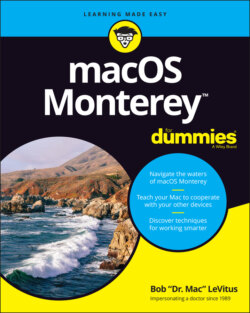Читать книгу macOS Monterey For Dummies - Bob LeVitus - Страница 16
What you should see on startup
ОглавлениеWhen you finally do turn on your Mac, you set in motion a sophisticated and complex series of events that culminates in the loading of macOS and the appearance of the macOS desktop. After a small bit of whirring, buzzing, and flashing (meaning that the OS is loading), macOS first tests all your hardware — slots, ports, disks, random access memory (RAM), and so on. If everything passes, you’ll see a tasteful whitish Apple logo in the middle of your screen, as shown in Figure 1-1.
FIGURE 1-1: This is what you’ll see if everything is fine and dandy when you turn on your Mac.
Here are the things that you might see when you power-up your Mac:
Login screen: You might or might not see the macOS login screen. Here, you choose your user account, enter your name and password, and press Return or Enter (or click the little right-arrow-in-a-circle in the password field), and away you go. If you don’t want to type your name and password every time you start or restart your Mac (or even if you do), check out Chapter 23 for the scoop on how to turn the login screen on or off. You should turn off the login screen only if you’re confident you’ll be the only one touching the machine. With the login screen disabled, your Mac and everything in it is completely available to anyone who turns it on, which is usually not a good thing. So I don’t recommend turning off the login screen if your Mac is a laptop. And even desktop Mac users should think twice before turning it off.Either way, the desktop soon materializes before your eyes. If you haven’t customized, configured, or tinkered with your desktop, it should look pretty much like Figure 1-2. Now is a good time to take a moment for positive thoughts about the person who convinced you that you wanted a Mac. That person was right!FIGURE 1-2: The desktop after a brand-spanking-new installation of macOS Monterey.
Blue/black/gray screen of death: If any of your hardware fails when it’s tested, you may see a blue, black, or gray screen.Some older Macs played the sound of a horrible car wreck instead of the chimes, complete with crying tires and busting glass. It was exceptionally unnerving, which might be why Apple doesn’t use it anymore. The fact that something went wrong is no reflection on your prowess as a Mac user. Something is broken, and your Mac may need repairs. If this is happening to you right now, check out Chapter 26 to try to get your Mac well again. If your computer is under warranty, set up a Genius Bar appointment at your nearest Apple Store or dial 1-800-SOS-APPL, and a customer service person can tell you what to do. Before you do anything, though, skip ahead to Chapter 26. It’s entirely possible that one of the suggestions there will get you back on track without your having to spend even a moment on hold.
Prohibitory sign or flashing question mark in a folder: Most users eventually encounter the prohibitory sign or flashing question mark in a folder (as shown in the margin). These icons mean that your Mac can’t find a startup disk, hard drive, network server, or DVD-ROM containing a valid Mac operating system. See Chapter 26 for ways to ease your Mac’s ills.
Kernel panic: You may occasionally see a block of text in several languages, including English, as shown in Figure 1-3. This means that your Mac has experienced a kernel panic, the most severe type of system crash. If you restart your Mac and see either message again, look in Chapter 26 for a myriad of possible cures for all kinds of ailments, including this one.
FIGURE 1-3: If you’re seeing something like this, things are definitely not fine and dandy.
How do you know which version of the macOS your computer has? Simple:
1 Choose About This Mac from the menu (the menu with the symbol in the top-left corner of the menu bar).A window pops up on your screen, as shown in Figure 1-4. The version you’re running appears just below macOS near the top of the window. Version 12.0 is the release we know as Monterey. If you’re curious or just want to impress your friends, you might want to know that version 11 was Big Sur; version 10.15 was Catalina; 10.14 was Mojave; 10.13 was High Sierra; 10.12 was Sierra; 10.11 was El Capitan; 10.10 was Yosemite; 10.9 was Mavericks; 10.8 was Mountain Lion; 10.7 was Lion; 10.6 was Snow Leopard; 10.5 was Leopard; 10.4 was Tiger; 10.3 was Panther; 10.2 was Jaguar; 10.1 was Puma; and 10.0 was Cheetah.
2 (Optional) Click the Overview, Displays, Storage, Support, or Resources tabs to see additional details about your Mac.
3 Click the System Report button to launch the System Information application and see even more details.The System Information app shows you even more about your Mac, including bus speed, number of processors, caches, installed memory, networking, storage devices, and much more. You can find more about this useful program in Chapter 25.
FIGURE 1-4: See which version of macOS you’re running.
